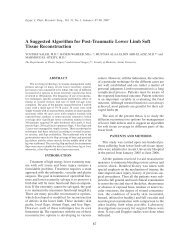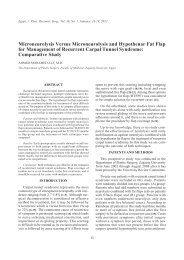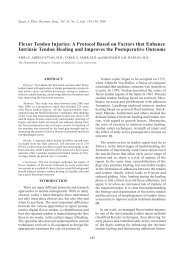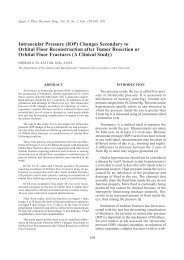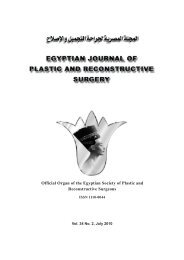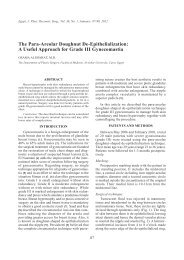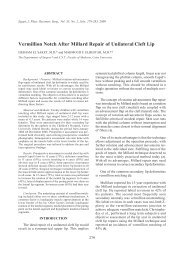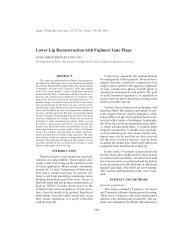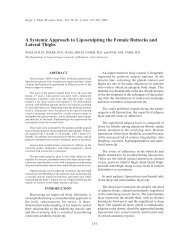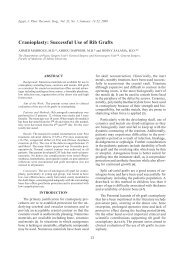Childhood Chin Trauma and Temporo-Mandibular Joint ... - ESPRS
Childhood Chin Trauma and Temporo-Mandibular Joint ... - ESPRS
Childhood Chin Trauma and Temporo-Mandibular Joint ... - ESPRS
Create successful ePaper yourself
Turn your PDF publications into a flip-book with our unique Google optimized e-Paper software.
Egypt, J. Plast. Reconstr. Surg., July 2011 181<br />
DISCUSSION<br />
Many studies [10-13] reported that the trauma<br />
was the most common aetiology of TMJ ankylosis<br />
(13-100%). Khan et al., 2010 found that trauma<br />
was the most common cause of TMJ ankylosis <strong>and</strong><br />
was confirmed in 96.7% of patients by an obvious<br />
scar mark under their chin <strong>and</strong> a history of chin<br />
trauma before the age of 10 years [14]. This study<br />
was agreed with the previous studies as the trauma<br />
was the most common cause of TMJ ankylosis.<br />
Moreover, the neglected diagnosis <strong>and</strong> the badly<br />
management hematoma of the TMJ were progressed<br />
up to fibrosis <strong>and</strong> ultimately to ankylosis.<br />
Majority of post-traumatic TMJ ankylosis was<br />
primarily attributed to delay or non-treatment of<br />
condylar fractures due to several factors such as<br />
poor educational levels, non-availability of surgical<br />
expertise, poor economic status <strong>and</strong> prolonged<br />
immobilization of the joint due to pain after injury<br />
[15].<br />
Our objective in the management of the TMJ<br />
ankylosis was to restore mouth opening, to establish<br />
a function outcome of the joint, to correct the facial<br />
profile <strong>and</strong> to relive the upper airway obstruction<br />
with minimal complications.<br />
Reconstruction of the m<strong>and</strong>ibular condyle remains<br />
a challenge because of its unique anatomical<br />
structure. Autogenous graft is generally considered<br />
the best reconstruction material as it is less in cost<br />
<strong>and</strong> time for preparation in comparison with allograft<br />
<strong>and</strong> it heals normally with little complications<br />
[16]. Costochondral graft is the most widely<br />
accepted autogenous technique for m<strong>and</strong>ibular<br />
condyle reconstruction. The costochondral graft<br />
is readily available, possesses good mechanical<br />
properties <strong>and</strong> has the capacity for remodeling into<br />
an adaptive m<strong>and</strong>ibular condyle [17].<br />
The unpredictable growth pattern of the costochondral<br />
grafts has often been cited as a disadvantage.<br />
Aberrant growth can cause progressive dental<br />
midline shifts, occlusal changes, chin deviation<br />
<strong>and</strong> enlargement of the graft itself [18].<br />
When treating the TMJ ankylosis with costochondral<br />
graft in this study, the good healing of<br />
the costochondral graft with the m<strong>and</strong>ibular ramus<br />
was confirmed <strong>and</strong> most patients showed no reankylosis<br />
inspite of Saeed <strong>and</strong> Kent in 2003 reported<br />
re-ankylosis <strong>and</strong> limited improvement in mouth<br />
opening [13]. Our explanation regarded to use an<br />
adequate amount of myofascial temporalis muscle<br />
flap as an interpositional graft was effective in the<br />
prevention of ankylosis recurrence. The main ad-<br />
vantages of using the autogenous myofascial temporalis<br />
muscle flap are its proximity to the operative<br />
site <strong>and</strong> its good blood supply.<br />
Since McCarthy use a distraction technique for<br />
m<strong>and</strong>ibular lengthening in the patients with hemifacial<br />
microsomia [19], Distraction osteogenesis<br />
has become a widely accepted natural surgical<br />
procedure in the treatment of craniofacial deformities<br />
<strong>and</strong> defects. Several series [20,21,22] confirmed<br />
that distraction osteogenesis is a promising treatment<br />
option for patients with TMJ ankylosis. Distraction<br />
osteogenesis has become a popular surgical<br />
modality due to many advantages: minimal complexity<br />
of the procedure, minimal operative time,<br />
minimal hospital stay, low risk of complications,<br />
no donor site morbidity, no need for blood <strong>and</strong> no<br />
IMF fixation required [23].<br />
Muscular resistance, particularly from masseter<br />
<strong>and</strong> medial pterygoid muscles is one of the most<br />
crucial factors in creating resistance during distraction<br />
osteogenesis, as well as during jaw exercises<br />
after releasing the ankylosis [23]. So, in this series<br />
the ptreygo-massertic sling was disinserted freely<br />
that resulting in maximal mouth opening.<br />
The authors regarded the reported experienced<br />
pain during the distraction period to the distraction<br />
forces pushing the remaining ramus up into the<br />
glenoid fossa.<br />
We observed that the postpond resection of the<br />
TMJ ankylosis to the second stage of surgery after<br />
distraction osteogenesis gave us the favorable<br />
results rather than the distraction osteogenesis<br />
came as the second stage. This emphasis that the<br />
immobile joint represented a fixed point that the<br />
distraction was pushed the m<strong>and</strong>ible downward<br />
for m<strong>and</strong>ibular lengthening with no harm effect<br />
on the non-reconstructed joint. Moreover, the<br />
enlarged bone segment in this stage appreciate the<br />
convenient osteotomy <strong>and</strong> appropriate placing of<br />
the costochondral graft in the second stage. On the<br />
other h<strong>and</strong>, the resection of TMJ ankylosis firstly<br />
<strong>and</strong> the distraction osteogenesis came later, it is<br />
going to lengthening the ramus towards the reconstructed<br />
joint destroying it <strong>and</strong> may hasted the<br />
ankylosis again.<br />
From the current study, the authors summarize<br />
<strong>and</strong> conclude that there is a direct relationship<br />
between the neglected childhood chin trauma <strong>and</strong><br />
TMJ ankylosis. So, we recommend to do<br />
ultrasonography on the TMJ with regular followup<br />
to examine the TMJ function as a routine for<br />
any patient with m<strong>and</strong>ibular trauma. Furthermore,<br />
the m<strong>and</strong>ibular distraction osteogenesis before the




